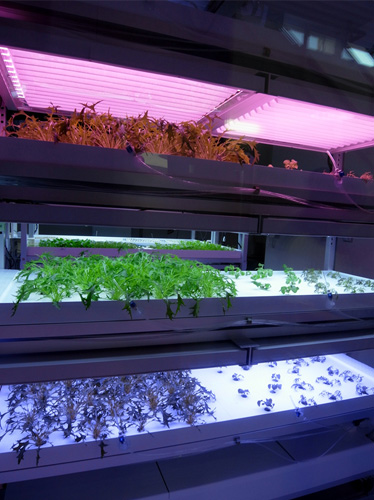
A plant factory at Meiji University; Photo Credit: VMⅡ
The German Federal Court of Justice declared a Nichia YAG LED patent[1] valid in a non-appealable decision on Aug. 16, 2016. The patent had been challenged by Taiwanese LED packaging firm Everlight in a two year battle, initially having been declared invalid in 2014. This may lead to the enforcement of a previous ban on the sale of six Everlight products handed down by a Dusseldorf court in 2014, which was suspended pending the validity challenge.
Everlight signed a cross-licensing agreement with Germany’s Osram in 2003, and its current range of white light LED products derives from a mixture of the two companies’ technology, which Nichia believes to infringe some of its core patents.
The patents held by Nichia derive from the work of physicists Isamu Akasaki, Hiroshi Amano and Shuji Nakamura, who won the Nobel Prize for Physics in 2014 for the invention of efficient blue light-emitting diodes which have enabled bright and energy-saving white light sources. Although the initial patents have expired, much of the core technology is still protected by Nichia, which has put pressure on competitors.
It was in this context that Lo I-Kai, a professor from National Sun Yat Sen University in Taiwan, began working on an invention that would circumvent not only the Nichia patents, but also the reliance on Chinese-controlled rare-earth resources for the technology involved. Lo recently spoke at a seminar during BioTaiwan 2016, introducing the core tenets of his technological innovation, which involves developing non-phosphor assisted white light LEDs using gallium nitride (GaN) as a semiconductor material.
The project was initially rolled out under Taiwan’s National Program on Nano Technology under the National Science Council (now the Ministry of Science and Technology) and US and Taiwan patents[5] have already been filed to protect the technology involved.
Lo’s short-term goal is to enter the plant factory and medical instrument sector, but in the long-term he is eying prospects in the AMOLED display sector.
Lo cited media reports which gave quite a pessimistic view of Japan’s plant factory industry, stating that many of these factories are on the verge of collapse. This view is mirrored in a recent Forbes article which suggests that around 70%-90% of plant factories in Japan are unprofitable largely due to low energy efficiency and temperature fluctuations, despite previous predictions that the industry would be worth US$4 billion by 2018. Lo used a medical analogy to explain what he thought was the stumbling block for the industry at present: you have to use the right medicine at the right time on the right patient to have the desired effect. Lo explained that sunlight is filtered by the earth’s atmosphere to a greater or lesser extent according to altitude, with different plants requiring a different spectrum frequency of light for optimal growth. He stated that currently these plant farms use either traditional fluorescent lamps, which produce a lot of heat, or the white-light LED technology developed by Nakamura. The white light LED technology that Nakamura developed uses Indium Gallium Nitride and are a combination of two frequency spectrums of light, one is blue light and the other is a red light which is converted to a yellow light with the use of a phosphor. When the yellow light and blue light combine this creates white light. Lo stated, however, that these aren’t necessarily the most efficient spectrum frequencies for plant factories, which grow a range of things, from vegetables to plants with a higher economic value, such as ginseng or lingzhi mushrooms. If the wrong light source is used, the leads to a reduced yield. Light therefore needs to be adjustable to mimic the differences between light in mountainous regions and that at sea level. Lo also remarked that manufacturers who mimic this technology by adding phosphor in a similar way are vulnerable to patent infringement suits. He stated that the use of phosphor also makes the LEDs less energy efficient, as energy is used up in absorption, creating heat, which is why current white light LEDs have life-span issues after long-term use, as the phosphor degrades over time. Excess heat can also create significant problems for plant factories.
Lo states that his invention is closer to a luminescent or “cold-light” LED. In addition to this, the phosphor used under the Nichia patents, Ce3 + Y3Al5O12, involves the use of Cerium, which is a rare-earth element, and China currently controls its price and supply. Lo stated that China has invested a lot of money in this sector, developing red, blue and green LEDs with the use of phosphors and given the size of the country’s market, it’s quite difficult for outsiders to compete, not even to mention the threat of litigation from Nichia. As Lo has gone a different route from the Nichia patents completely, his technology is not vulnerable to patent litigation from them.
Lo pointed to the “green gap” which exists in LED technology, in that highly efficient green and deep green LED light (525 - 555 nm) is still not attainable without the use of phosphor conversion, which means that green LEDs are quite low in efficiency. Lo overcame the deadlock Nakamura met in creating yellow light without the use of phosphor with the use of a different substrate material. Whereas Nakamura used sapphire as a substrate, Lo’s method suggests the use of other substrates, such as lithium aluminum, lithium gallate and zinc oxide, using the Czochralski process, which will eventually enable him to produce gallium nitride which can be adjusted to give off red, blue and green light, which then can be combined to make white light. To avoid infringing the Nichia patents, Lo does not use the metalorganic chemical vapor deposition (MOCVD) process, instead using molecular beam epitaxy (MBE). They have successfully produced a monocrystalline gallium nitride microdisk. The gallium nitride they produce has a Wurtzite structure, which functions as a quantum well, different in structure from the same material as used by Nakamura. When this is formed into a double quantum well, it enables them to produce yellow light, stronger than even blue light. This was the first stage of their project, essentially achieving what Nakamura had achieved without the use of a phosphor, creating a binary LED with blue and yellow light.
The next step was how to commercialize this product. This involved creating a component and ensuring that these devices could be produced in a uniform way, as micro-disks.
At every stage of the research and development process, patent protection has been at the forefront of Lo’s mind, he stated.
As well as application in plant factories, the technology can also be used in medical instruments, said Lo, citing the example of a doctor’s headlight, as if excess heat is produced this can lead to sweat, which poses the risk of infection.
He aims to start from smaller markets like plant factories and medical instruments due to the lower barriers for entry, but eventually they plan to develop the technology into a 2x2 array, progressing to displays, particularly OLED (used in mobile phones) and AMOLED panel displays.
Reference:
- DE69702929
- TW383508
- US5,998,925 and US7,531,960
- JP4530094
- US 8728235 (ROC I398558); US 8766237 B2 (ROC I416762); US 8916458 B2 (ROC 201417336); US 9147808
 |
|
| Author: |
Conor Stuart |
| Current Post: |
Senior Editor, IP Observer |
| Education: |
MA Taiwanese Literature, National Taiwan University
BA Chinese and Spanish, Leeds University, UK |
| Experience: |
Translator/Editor, Want China Times
Editor, Erenlai Magazine |
|
|
|
| Facebook |
|
Follow the IP Observer on our FB Page |
|
|
|
|
|
|



